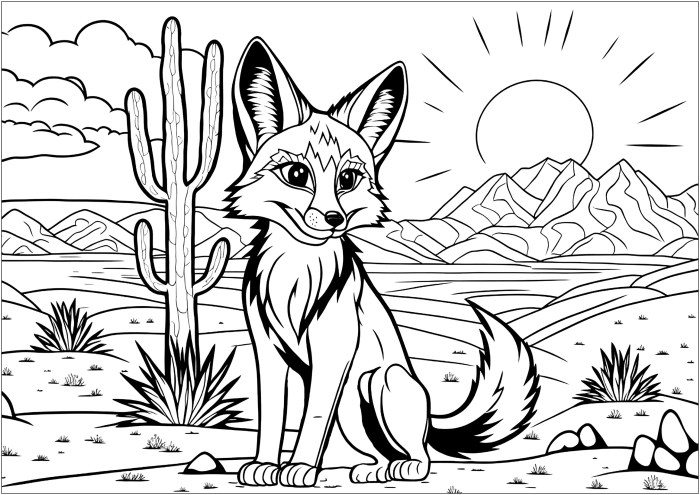Desert Animal Characteristics for Coloring Pages: Desert Animal Coloring Pages Easy

Desert animal coloring pages easy – Creating engaging coloring pages for children requires careful consideration of the animals’ key features. Simplicity is key, allowing young artists to focus on the fun of coloring while still learning about these fascinating creatures. This section details the physical characteristics of five common desert animals, suitable for easy representation in coloring page format.
Physical Features of Desert Animals
The following descriptions highlight the easily recognizable features of five desert animals, emphasizing simplicity for children’s coloring pages. These features are easily translated into simple shapes, making them ideal for young artists.
- Camel: Camels possess a hump (or humps), long neck, long legs, and a relatively small head. Their coats can be various shades of brown or tan. Their large, expressive eyes are also a distinctive feature.
- Scorpion: Scorpions have a segmented body, a long, thin tail ending in a stinger, and large pincers. Their bodies are typically a dark brown or black color.
- Cactus Wren: This small bird is characterized by its long tail, short, rounded wings, and a relatively large head. They are typically a light brown or gray color with subtle markings.
- Desert Tortoise: Desert tortoises have a high-domed shell, short, thick legs, and a strong beak. Their shells are usually a light tan or brown color with darker markings.
- Roadrunner: Roadrunners have long legs, a long tail, and a long, pointed beak. Their plumage is typically a mixture of browns, grays, and whites, often with subtle streaks or spots.
Simple Shapes for Representing Desert Animals
The following list provides simple shapes that can be used as a base for drawing each of the five desert animals. These shapes will serve as a foundation for children to add details and color.
- Camel: A combination of an oval (body), a rectangle (neck), and smaller circles (head and humps).
- Scorpion: Several connected rectangles and triangles (body segments and tail), plus circles for the pincers.
- Cactus Wren: An oval (body), a long triangle (tail), and a small circle (head).
- Desert Tortoise: A large oval or dome shape (shell), with smaller rectangles and circles for the legs and head.
- Roadrunner: An oval (body), long rectangles (legs and tail), and a triangle (beak).
Color Palettes for Desert Animals
Utilizing a limited, simple color palette enhances the coloring experience for children. The following suggestions offer basic color options for each animal.
- Camel: Browns, tans, and light beige.
- Scorpion: Dark brown, black, and possibly a touch of reddish-brown for accents.
- Cactus Wren: Light brown, gray, and perhaps a very pale yellow for undertones.
- Desert Tortoise: Light tan, brown, and darker brown for shell markings.
- Roadrunner: Browns, grays, and white.
Designing Simple Coloring Page Layouts

Effective layout design is crucial for creating engaging and easy-to-use coloring pages. A well-structured layout enhances the coloring experience, guiding the user and preventing overcrowding or confusion. This section explores various layout options using HTML tables, focusing on simplicity and responsiveness.
Single-Animal Coloring Page Layouts
Three distinct layouts are presented below, each utilizing HTML tables to achieve different visual effects. These examples demonstrate how a simple table structure can be adapted to create diverse and appealing designs. Responsiveness is achieved through the use of percentage-based widths.
Layout 1: Large Central Image
This layout emphasizes the main image, providing ample space for coloring. <table style="width:100%;"> <tr> <td colspan="4" style="text-align:center;"> <img src="desert_animal.png" alt="Desert Animal" style="max-width:80%; height:auto;"> </td> </tr></table>
Layout 2: Border Design
This layout uses the table to create a border around the central image, adding a decorative element. <table style="width:100%; border-collapse: collapse;"> <tr> <td style="width:10%; border: 2px solid black;"></td> <td style="width:80%; text-align:center;"> <img src="desert_animal.png" alt="Desert Animal" style="max-width:100%; height:auto;"> </td> <td style="width:10%; border: 2px solid black;"></td> </tr></table>
Layout 3: Abstract Design
This layout uses the table to create a more abstract and less structured design, potentially incorporating decorative elements within the table cells. <table style="width:100%;"> <tr> <td style="width:30%; background-color:#f0f0f0;"></td> <td style="width:40%; text-align:center;"> <img src="desert_animal.png" alt="Desert Animal" style="max-width:100%; height:auto;"> </td> <td style="width:30%; background-color:#f0f0f0;"></td> </tr></table>
Multi-Animal Coloring Page Layout
This layout displays five desert animals using a four-column table structure. The arrangement maximizes space utilization while ensuring each animal remains clearly visible. <table style="width:100%;"> <tr> <td><img src="animal1.png" alt="Animal 1" style="max-width:100%; height:auto;"></td> <td><img src="animal2.png" alt="Animal 2" style="max-width:100%; height:auto;"></td> </tr> <tr> <td><img src="animal3.png" alt="Animal 3" style="max-width:100%; height:auto;"></td> <td><img src="animal4.png" alt="Animal 4" style="max-width:100%; height:auto;"></td> </tr> <tr> <td colspan="2"><img src="animal5.png" alt="Animal 5" style="max-width:100%; height:auto;"></td> </tr></table>
Animal Arrangement Approaches for Multi-Animal Pages, Desert animal coloring pages easy
Three approaches are Artikeld to improve the visual appeal and ease of coloring for multi-animal coloring pages. These methods focus on balancing visual weight and avoiding overcrowding.
Approach 1: Grid Layout This approach arranges animals in a consistent grid pattern, creating a balanced and organized look. This is easily achieved using a table structure as shown in the previous example.
Approach 2: Size Variation This approach utilizes images of varying sizes to create visual interest. Larger animals can be placed centrally, while smaller animals can fill in surrounding spaces. This method requires careful consideration of image proportions to maintain balance.
Approach 3: Grouping by Similarity This approach groups similar animals together (e.g., reptiles together, mammals together). This creates visual coherence and helps the user understand the relationships between the animals.
Desert animal coloring pages, often featuring simplified designs of creatures like camels and scorpions, provide a straightforward introduction to animal coloring for young children. A contrasting yet equally engaging option for developing fine motor skills and color recognition is found in resources like cute baby arctic animals coloring pages , which offer a different set of adorable subjects.
Returning to desert animal coloring pages, the ease of their designs makes them ideal for beginners.
